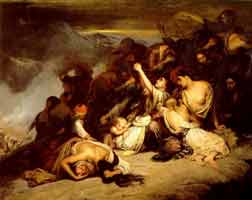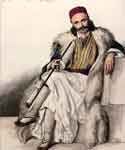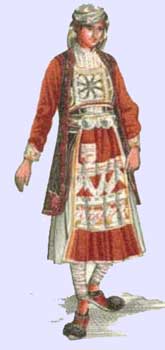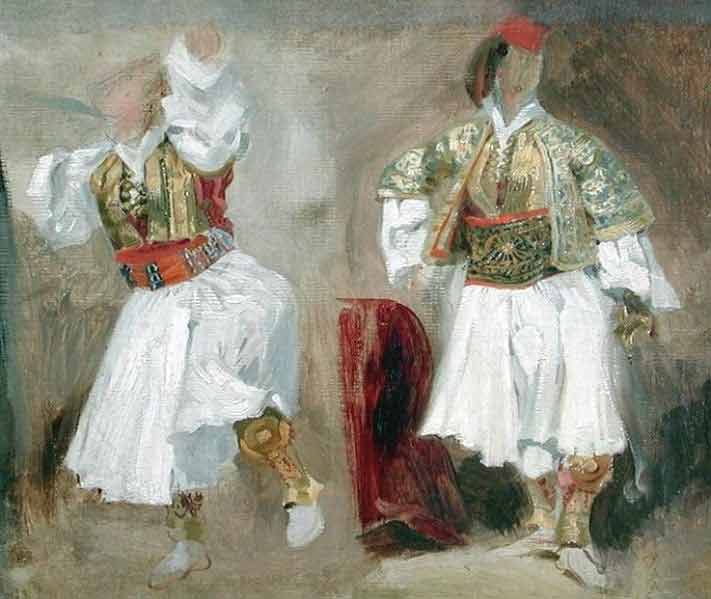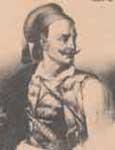|
|
The breathtaking mountains of Souli. The Σουλιώτες (Souliotes), also known as Suliots and anciently as Σελλοί (Selloi), are the inhabitants of Σούλι (Souli) in the mountains of Mourgas in Epirus in northwestern Greece. They are the villagers of the "Τετραχώρι" (Τetrahori -- four villages) who made themselves famous in the 19th century by their resistance to the Ottoman Empire. Ptolemy (Geographica, 3, 15) calls Epirus "primordial Hellas" and Aristotle (Meteorologica, I.352a) reports that an ancient cataclysm was most severe "in ancient Hellas, in between Dodona and the Achelous river [...], the land occupied by Selloi (or Helloi) and Graeci who later came to be known as Hellenes." The Souli were addressed by the Greek poet Andreas Kalvos (1792 – 1869) as the modern descendants of the Selloi, in his ode "Eis Souli" or "To the Souli". In support of the poet's belief, a Greek historian, Constantine Pantazi proved that the area that is currently Epirus in northwestern Greece was populated by one of the first ancient Hellenic tribes, the Selloi since 800 BC. The area was called Thesprotia by the Selloi. About 1600 A.D., the Souli migrated from the plains of Thesprotia up into the mountains of Mourgas, where a confederacy of clans presented a united front to the Ottomans [1]. The Ottoman Turks attempted numerous times to conquer the territories of the Souliot Confederacy. In 1731, Hatzi Achmet, pasha of Ioannina, received orders from the Sultan to subdue the Souliots. He lost his army of 8000 men. In 1754, Mustapha Pasha lost his army to the Souliotes too. In the following years, Mustapha Kokka came in with 4000 soldiers and Bekir Pasha with 5000. Both failed to defeat the Souliotes. In 1759, Dost Bey, commander of Dhelvinou, was defeated by the Souliotes. Maxoud Aga of Margariti, the governor of Arta, suffered the same fate in 1762. In 1772, Suleiman Tsapari attacked the Souliotes with his army of 9000 men and was defeated. In 1775, an expedition of Kurt Pasha failed. When in 1788 the notorious Ali became pasha of Ioannina, he tried for 15 years to destroy the Souliotes. In 1792, his army of 3000 Turko-Albanians was eliminated. Although he had hostages (such as Fotos Tzavellas who was the son of Lambros Tzavellas), Suliotes under the command of Georgios Botsaris, Lambros Tzavellas, and Dimos Drakos fought very bravely. Even women under the command of Moscho (Lambros Tzavellas' wife) participated in the battle. Eventually, 2000 Turko-Albanians and 74 Souliots were killed [2].
The Souliot Women A painting by Ary Scheffer(1795-1858), "The women, entrapped, turned towards the steep cliff. It was December 16, 1803 when the dance began. As the enemy charged against them, the women one-by-one threw their children from the cliff before jumping after them themselves. The decision: to choose death over enslavement" (1827 - Oil on canvas, Musιe du Louvre, Paris, France). The Souliotes obtained all of their supplies from Parga, and also acquired support from Europe. Russia and France provided weapons and ammunition to them. For the European powers, the Souliotes were seen as an instrument to weaken the Ottoman Empire. When the British politicians turned to the Ottoman Empire in order to strengthen their forces against Napoleon, the weapons and ammunition supplies were interrupted. Without support from outside and wearied by years of siege, the unity of the Souliot clans started to split. The Botsaris family for political reasons left Souli and parleyed with Ali Pasha. However, the remaining Souliotes gathered together in Saint George's Greek Orthodox Church, Souli, and decided to win or to die. They were no more than 2000 armed men. The main leaders were Fotos Tzavellas, Dimos Drakos, Tousas Zervas, Koutzonikas, Gogkas Daglis, Yiannakis Sehos, Fotomaras, Veikos, Panou, Zigouris Diamadis, and Yorgos Bousbos. The Souliotes won all of the decisive battles, so Ali Pasha was forced to build castles in neighboring villages and prepared himself for a long siege. The Souliots stayed without food and ammunition, but they could have held longer if not for a traitor named Pelios Gouses who helped the Ottomans to enter into the village of Souli. The Souliots withdrew to the fortresses of Kiafa and Kughi, where they fought their last battle on December 7, 1803. They eventually capitulated and Ali Pasha promised to release them with all of their property and even weapons to the Ionian Islands [3]. Souliot traditional dress On December 12, 1803, the Souliotes left Souli towards the coast of Epirus. A monk named Samuel remained in Kughi and set fire to the powder magazines with a massive explosion that cost him his life. In the meantime, the Turkish army attacked the other Souliots, neglecting the promises Ali Pasha had made to them. It was December 16, 1803, and 22 Souliot women were trapped on the cliffs of Zalongo. They turned towards the steep cliff while their dance began. As the enemy charged against them, the women one-by-one threw their children from the cliff of Zalongo before jumping after them. The women ultimately chose death over enslavement. Today, a monument stands on the cliffs of Zalongo as a tribute to the indomitable spirit of the Souliot women, and the popular Dance of Zalongo is danced throughout Greece. A number of Souliotes also reached the harbor of Parga, which was under Russian control at the time. The Souliots either settled down in Parga or set off for the Ionian Islands. Many Souliotes entered service with the Russians on Corfu, where they became an important component of the Legion of Light Riflemen. This was a regiment of irregulars organized by the Russians among mainland refugees; it not only included Suliotes, but also Himariotes, Maniots, klephts (Greek bandits) and armatoli (Greek anti-klepht militias created by the Ottomans that actually supported the klephts). The Suliots participated in campaigns in Naples in 1805, Tenedos in 1806, Dalmatia in 1806, and during the defense of Lefkas in 1807.
Souliotisa traditional dress With the Treaty of Tilsit in 1807 and the détente between Russia and France, the Russian forces withdrew from the Ionian Islands and the French occupied them. The Souliots and other components of Russian units entered service with the French in a unit known as the Suliot Regiment (Régiment Souliot). During the Anglo-French struggle over the Ionian Islands between 1810 and 1814, the Souliotes in French service faced off against other refugees organized by the British into the Greek Light Infantry Regiment. Since the Souliotes were mostly garrisoned on Corfu, which remained under French control until 1814, very few entered British service.
Souliotes in traditional costume. Oil painting by Eugene Delacroix 1824 - 1825; Louvre Museum, France. The British disbanded the remnants of the Suliot Regiment in 1815 and subsequently decommissioned their own two Greek Light Regiments. This left many of the Souliotes and other military refugees without livelihoods. In 1817, a group of veterans of Russian service on the Ionian Islands traveled to Russia to see if they could get patents of commission and employment in the Russian army. While unsuccessful in this endeavor, they joined the Philike Etaireia ("Company of Friends"), the secret society founded in Odessa in 1814 for the purpose of liberating Greek lands from Ottoman rule. They returned to the Ionian Islands and elsewhere and began to recruit fellow veterans into the Philike Etaireia, including a number of Souliot leaders. When there were clear signs for the beginning of a Greek insurrection against Turkish rule, Ali Pasha saw an opportunity to make Epirus into an independent state. In 1820, he called upon the Souliotes for help, and they returned to the mainland to support their former enemy against the Sultan. However, Ali Pasha's plans failed and he was killed while the Turks occupied Ioannina. The Souliotes eventually gave their support for the Greek Revolution, which started on March 25, 1821. The Souliot leaders Markos Botsaris and Kitsos Tzavellas became famous generals in the Greek War of Independence. Many Souliotes lost their lives while defending the city of Messolongi. Lord Byron, the most prominent European philhellene volunteer and commander-in-chief of the Greek army in Western Greece, tried to integrate the Souliotes into a regular army. Until 1909, the Turks kept a military base on the fortress of Kiafa. Finally in 1913, during the Balkan Wars, the Greek army liberated the southern part of Epirus [4].
See also Links Souli: The Impregnable Fortress Retrieved from "http://en.wikipedia.org "
 |
|||||||||||||||

